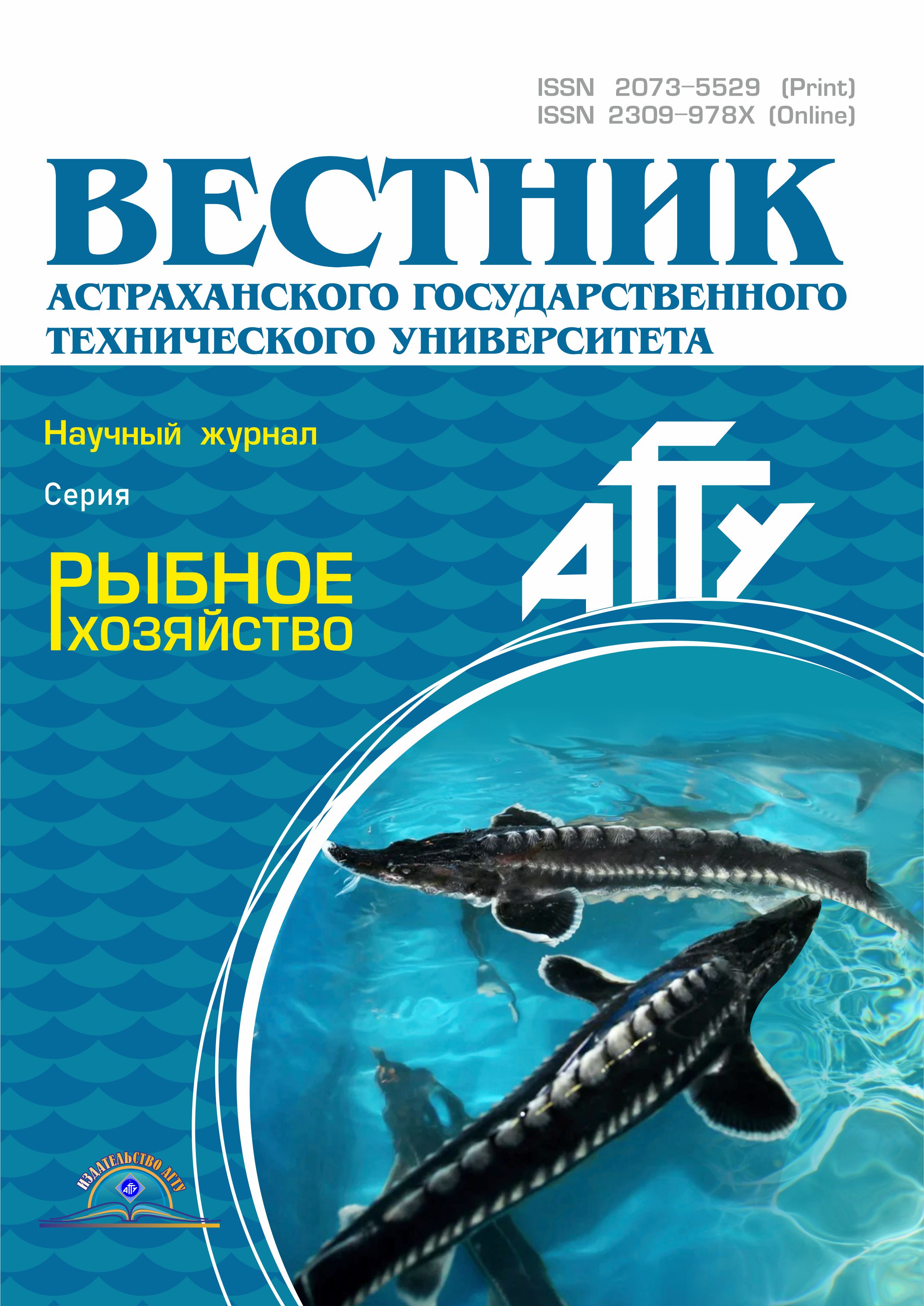Volga-Caspian branch of All-Russian Research Institute of Fisheries and Oceanography (Head of the Laboratory of Hydrobiology)
Volga-Caspian branch of All-Russian Research Institute of Fisheries and Oceanography (Senior Researcher of the Laboratory of Water Problems and Toxicology)
Russian Federation
CSCSTI 34.39
CSCSTI 62.13
CSCSTI 69.01
CSCSTI 69.25
CSCSTI 69.31
CSCSTI 69.51
CSCSTI 87.19
For the first time in the history of the researches on nutrition of benthic organisms in the Northern Caspian Sea, the assessment of statistical regularities between the content of organic matter in soils and benthos is made. Based on the ascertained statistical connections, there were defined 2 groups of benthic organisms: the biomass and number of the 1st group are negatively correlated with the level of accumulation of organic carbon, while the biomass and number of the 2nd group are positively dependent on the content of organic carbon. The concentration of organic carbon in bottom sediments of the Northern Caspian Sea for the period 1994-2011 changed from 0.01 to 2.82 %. Territorial distribution was heterogeneous. The greatest accumulation of organic carbon was fixed in sludgy soils. The destruction of organic matter in bottom sediments is caused by the abundance and biomass of infauna ( Chironomidae , Hypaniola kowalevskyi , Hediste diversicolor ). This group of organisms reduces a quantity of organic matter enhancing oxygen flow due to mechanical effect on the ground during the migration period. The coefficient of correlation between organic carbon and quantitative indicators of this group of organisms changed from -0.51 to -0.89. The most significant contact was fixed between organic carbon and the number of Chironomidae. The accumulation of organic carbon in the bottom sediments influences the abundance and the biomass of some representatives of nektobenthos ( Mysidae ), endobios ( Didacna protracta ), collectors ( Abra ovata ) and filter feeders ( Hypaniа angusticostata ). A positive correlation indicates an important role of organic matter in the nutrition of these hydrobionts. The coefficient of correlation between organic carbon and the number and biomass of the above-listed organisms changed from +0.67 to +0.93. The highest values of the correlation coefficient are fixed between the organic carbon content and the number of Paramysis ullskyi ( Mysidae ).
organic carbon, bottom sediments, the Northern Caspian Sea, abundance of zoobenthos, biomass of zoobenthos
1. Yablonskaya E. A. Pitanie Nereis succinea v Kaspiyskom more / E. A. Yablonskaya // Sb. rabot ob akklimatizacii Nereis succinea v Kaspiyskom more. M.: Izd-vo Mosk. o-va ispytateley prirody, 1952. Vyp. 33. S. 285-351.
2. Romanova N. N. Sposoby pitaniya i pischevye gruppirovki donnyh bespozvonochnyh Severnogo Kaspiya / N. N. Romanova // Tr. Vsesoyuz. gidrobiol. o-va. 1963. T. XIII. S. 146-177.
3. Yablonskaya E. A. Vodnaya vzves' kak pischevoy material dlya organizmov bentosa Kaspiyskogo morya / E. A. Yablonskaya // Tr. VNIRO. 1969. T. LXV. S. 85-147.
4. Yablonskaya E. A. Issledovanie troficheskih svyazey v donnyh soobschestvah yuzhnyh morey / E. A. Yablonskaya // Resursy biosfery. 1976. Vyp. 2. S. 117-144.
5. Hunt O. D. The food of the bottom fauna of the Plymouth / O. D. Hunt // J. Marine Biol. Assoc. U. K. 1925. Vol. 13. P. 560-599.
6. Briskina M. M. Sostav pischi donnyh bespozvonochnyh v severnoy chasti Kaspiyskogo morya / M. M. Briskina // Dokl. VNIRO. 1952. Vyp. I. S. 126-131.
7. Yablonskaya E. A. Mnogoletnie izmeneniya biomassy raznyh troficheskih grupp bentosa Severnogo Kaspiya / E. A. Yablonskaya // Tr. VNIRO. 1975. T. CVIII. S. 50-64.
8. Izosimov V. V. Klass maloschetinkovyh chervey Oligochaeta. Rukovodstvo po zoologii / V. V. Izosimov. M.: Izd-vo AN SSSR, 1940. T. 2. S.157-204.
9. Klenova M. V. Geologiya morya / M. V. Klenova. M.: Uchpedgiz, 1948. 495 s.
10. Martynova M. V. Rol' nekotoryh bentosnyh organizmov v udalenii soedineniy N i R iz donnyh otlozheniy (obzor) / M. V. Martynova // Gidrobiologicheskiy zhurnal. 1985. T. 21, № 6. S. 44-48.
11. Matisoff G. Particle mixing by freshwater infaunal bioirrigators: Midges (Chironomidae: Diptera) and mayflies (Ephemeroptera) / G. Matisoff, W. Xiaosong // J. Great Lakes Res. 2000. Vol. 26, no. 2. P. 174-182.
12. Ólafsson J. S. Alteration of biogenic structure and physical properties by tube-building chironomid larvae in cohesive sediments / J. S. Ólafsson, D. M. Paterson // Aquat. Ecol. 2004. Vol. 38, no. 2. P. 219-229.
13. Vinogradov L. G. Predstoyaschie izmeneniya kaspiyskoy kormovoy fauny i neobhodimye mery po ee ukrepleniyu / L. G. Vinogradov // Tr. VNIRO. 1959. T. 38, vyp. 1. S. 165-175.
14. Metodicheskoe rukovodstvo po analizu organicheskogo veschestva donnyh otlozheniy / pod red. E. M. Zaslavskogo. M.: VNIRO, 1980. 64 s.
15. GOST 26213-91. Pochvy. Metody opredeleniya organicheskogo veschestva. M.: Komitet standartizacii i metrologii, 1993. 8 s.
16. Atlas bespozvonochnyh Kaspiyskogo morya / pod red. Ya. A. Birshteyna i dr. M.: Pisch. prom-st', 1968. 414 s.
17. Kaspiyskoe more: fauna i biologicheskaya produktivnost' / pod red. E. A. Yablonskoy. M.: Nauka, 1985. 278 s.
18. Malinovskaya L. V. Sostoyanie donnoy fauny Kaspiyskogo morya v 2004 g. / L. V. Malinovskaya, L. A. Kochneva // Rybohozyaystvennye issledovaniya na Kaspii: Rezul'taty NIR za 2004 g. Astrahan': Izd-vo KaspNIRH, 2005. S. 140-148.
19. Malinovskaya L. V. Dinamika zoobentosa Severnogo Kaspiya v period pod'ema urovnya morya / L. V. Malinovskaya, T. D. Zinchenko // Izv. Samar. nauch. centra RAN. 2012. T. 14, № 5. S. 179-185.
















